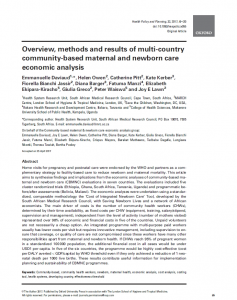
Home visits for pregnancy and postnatal care were endorsed by the WHO and partners as a complementary strategy to facility-based care to reduce newborn and maternal mortality. This article aims to synthesise findings and implications from the economic analyses of community-based maternal and newborn care (CBMNC) evaluations in seven countries. The evaluations included five cluster randomized trials (Ethiopia, Ghana, South Africa, Tanzania, Uganda) and programmatic before/after assessments (Bolivia, Malawi). The economic analyses were undertaken using a standardized, comparable methodology the ‘Cost of Integrated Newborn Care’ Tool, developed by the South African Medical Research Council, with Saving Newborn Lives and a network of African economists. The main driver of costs is the number of community health workers (CHWs), determined by their time availability, as fixed costs per CHW (equipment, training, salary/stipend, supervision and management), independent from the level of activity (number of mothers visited) represented over 96% of economic and financial costs in five of the countries. Unpaid volunteers are not necessarily a cheap option. An integrated programme with multi-purpose paid workers usually has lower costs per visit but requires innovative management, including supervision to ensure that coverage, or quality of care are not compromised since these workers have many other responsibilities apart from maternal and newborn health. If CHWs reach 95% of pregnant women in a standardized 100 000 population, the additional financial cost in all cases would be under USD1 per capita. In five of the six countries, the programme would be highly cost-effective (cost per DALY averted < GDP/capita) by WHO threshold even if they only achieved a reduction of 1 neonatal death per 1000 live births. These results contribute useful information for implementation planning and sustainability of CBMNC programmes.
*This article is part of a series of eight papers that includes the first multi-country, economic and systems analyses of community based maternal-newborn care. Access the series here >>